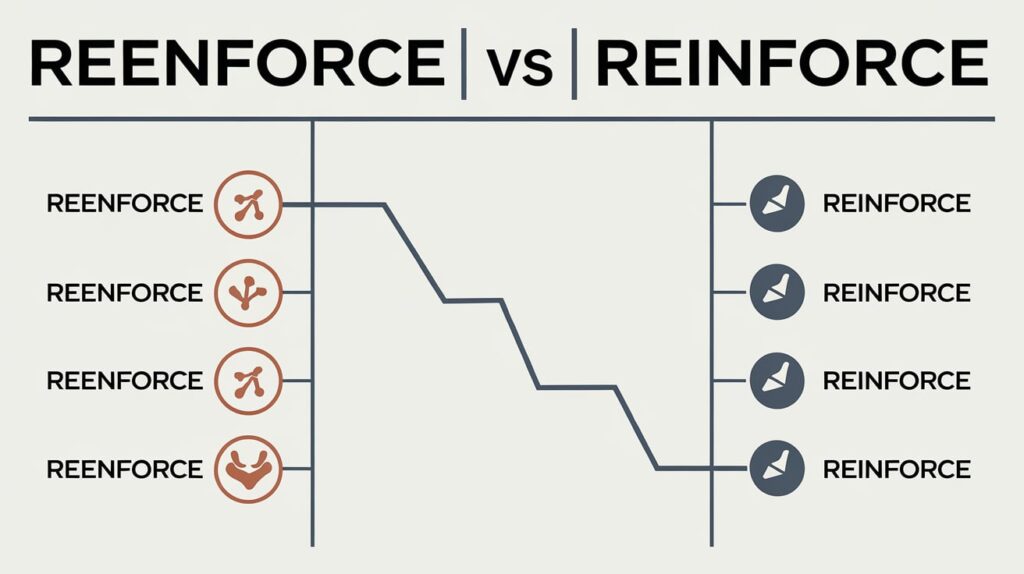When it comes to the words reenforce vs reinforce, many people find themselves confused about which term to use. This confusion often stems from their similar spelling and sound, yet they have distinct meanings and usages.
In this article, we will thoroughly explore reenforce vs. reinforce, clarifying their meanings, proper usage, and the contexts in which each word is appropriately applied.
As we delve into this topic, you will discover examples, historical usage, and much more, helping you confidently decide when to use reenforce or reinforce.
By the end of this comprehensive guide, you’ll not only understand the differences but also recognize how to apply this knowledge in your writing and everyday conversations.
Which One is Right – Reenforce or Reinforce? What’s the Main Answer?
The main answer to the question of whether to use reenforce or reinforce is quite simple: reinforce is the correct form to use in standard English. The term reenforce is rarely accepted and can be considered incorrect in most contexts. To ensure clarity and precision in your communication, it is advisable to use reinforce consistently.
1. Spelling of Reenforce and Reinforce
Let’s begin with the spelling of these two terms.
Reenforce: This term combines the prefix “re-” (meaning “again” or “back”) with “enforce.” While it may seem plausible, this is not a standard term in English.
Reinforce: This word combines the prefix “re-” with the root word “force,” indicating the action of strengthening or supporting something. The correct spelling is essential in formal writing and communication.
2.Definition of Reenforce vs. Reinforce

To fully understand reenforce vs. reinforce, we need to delve into their definitions.
Reenforce: Often viewed as a misspelling, this term suggests a repetitive action related to enforcing something. However, it lacks a distinct meaning recognized in standard English.
Reinforce: To reinforce means to strengthen or support an idea, behavior, or physical structure. For instance, when a teacher uses additional materials to support a lesson, they are working to reinforce students’ understanding of the topic.
read more : Emersion Vs Immersion: Meaning, Differences, and Examples – Grammar Beacon
3. Usage of Reenforce and Reinforce
When discussing reenforce vs. reinforce, it’s crucial to know how each term should be used. Here are some examples that highlight the correct usage of reinforce:
- Correct: “The construction workers needed to reinforce the roof to ensure it could withstand heavy snowfall.”
- Incorrect: “The construction workers needed to reenforce the roof to ensure it could withstand heavy snowfall.”
In both written and spoken contexts, using reinforce ensures that your message is clear and accurate.
4. Historical Usage of Reenforce and Reinforce
The term reinforce has a long-standing presence in the English language. It has its roots in Latin, deriving from the term “reinforcare,” which means “to strengthen.” Throughout history, reinforce has been utilized across various fields, including:
- Military: Used to describe the act of adding troops or resources to strengthen a position.
- Construction: Referring to the strengthening of structures to ensure safety and durability.
- Education: In the context of teaching, where techniques are employed to bolster students’ understanding.
In contrast, reenforce has not established itself in historical usage. It often appears in casual conversations but lacks credibility in formal or academic writing.
5. Regional Differences of Reenforce and Reinforce
While reinforce is accepted globally, reenforce may be encountered occasionally in informal settings or specific regional dialects. However, even in these cases, reinforce remains the preferred term.
In formal communication, it’s best to consistently use reinforce to maintain professionalism and clarity.
6. Etymology of Reenforce and Reinforce
To further understand reenforce vs. reinforce, let’s explore their etymology:
Reenforce: This term does not have a significant etymological history. It is essentially a constructed word that combines “re-” with “enforce,” but lacks a proper place in English vocabulary.
Reinforce: The word is derived from the Latin root “reinforcare,” which translates to “to strengthen again.” The prefix “re-” implies repetition, while “force” relates to strength.
7. Verb Forms of Reenforce and Reinforce

The conjugation of reinforce is straightforward:
- Base Form: Reinforce
- Present: Reinforces
- Past: Reinforced
- Present Participle: Reinforcing
In contrast, reenforce does not have a widely recognized conjugation because it is not typically accepted in standard English.
8. Noun Forms of Reenforce and Reinforce
Reinforce: The corresponding noun form is reinforcement, which refers to the process of strengthening or supporting something. For example, “The teacher’s use of games was a form of reinforcement that helped students learn.”
Reenforce: There is no standard noun form for reenforce, as it is not widely accepted in the language.
9. Examples of Reinforce
To clarify the usage of reinforce, here are various examples across different contexts:
- In Education: “To help students remember the material, teachers often use visual aids to reinforce their lessons.”
- In Psychology: “Behavioral scientists utilize positive feedback to reinforce good habits in children.”
- In Construction: “To prevent structural failure, engineers must reinforce bridges with additional supports.”
- In Marketing: “The new advertising campaign was designed to reinforce brand loyalty among consumers.”
- In Sports: “The coach implemented strategies to reinforce teamwork and communication during practice.”
Reinforce vs. Reenforce Grammar
When considering reenforce vs. reinforce, it’s essential to always opt for reinforce in both spoken and written contexts. Here are some grammar tips to help you use reinforce effectively:
- Use reinforce when discussing the support or strengthening of ideas, behaviors, or physical structures.
- Avoid using reenforce; doing so can lead to misunderstandings or the impression of a lack of knowledge.
What Word Can I Use Instead of Reinforce?
If you find yourself wanting to use a synonym for reinforce, consider the following alternatives:
- Strengthen: To make something stronger or more forceful.
- Bolster: To support or strengthen an idea, argument, or structure.
- Support: To hold up or provide assistance in various contexts.
Using these synonyms can enhance your writing while still conveying similar meanings.
What Does Reinforce Mean in a Sentence?
Here’s how you might use reinforce in a sentence:
- “The counselor’s advice helped to reinforce my decision to pursue my career goals.”
How Do You Spell the Word Reenforces?
The correct spelling is reinforces. The term reenforces is not typically recognized in formal English and should be avoided.
What Is Reinforce as an Adjective?
Reinforce itself does not function as an adjective. However, the adjective form derived from it is reinforced, which describes something that has been made stronger. For example, “The reinforced concrete can withstand significant pressure.”
What Is Reinforce Performance?
Reinforce performance refers to techniques or strategies implemented to strengthen an individual’s or team’s performance. This may involve feedback, encouragement, or additional training to help improve results.
The Importance of Reinforcement in Learning

In the realm of education, reinforcement plays a crucial role. Teachers and educators utilize various methods to reinforce concepts and skills, ensuring that students can recall and apply what they’ve learned. Here are some key points on how reinforcement functions in education:
Positive Reinforcement: This involves providing rewards for desired behaviors or accomplishments. For instance, a teacher may give praise or extra credit to students who excel in their assignments, thus reinforcing their motivation to learn.
Negative Reinforcement: This term describes the removal of an unpleasant stimulus when a desired behavior occurs. For example, if a student consistently submits homework on time, a teacher may stop giving reminders, thereby reinforcing the student’s punctuality.
Reinforcement Schedules: These are used to determine how often a behavior is rewarded. Various schedules can be employed, such as fixed-ratio, variable-ratio, fixed-interval, and variable-interval schedules, all of which aim to reinforce learning in different ways.
read more : Hayday or Heyday: What’s the Right Word to Use? – Grammar Beacon
Reinforcement in Behavioral Psychology

Behavioral psychology heavily relies on the principles of reinforcement to modify behavior. Here are some insights into how this works:
Conditioning: Through classical and operant conditioning, psychologists can reinforce desired behaviors. For instance, in operant conditioning, a behavior followed by a reward is likely to be repeated. This process is vital for behavior modification techniques.
Application in Therapy: Therapists often use reinforcement strategies to encourage positive changes in behavior. For example, rewarding a patient for achieving small goals can help them stay motivated during therapy sessions.
Reinforcement and Habit Formation: Understanding how reinforcement affects habit formation can be beneficial. Consistent rewards for positive actions can lead to the establishment of good habits over time.
The Role of Reinforcement in Business
In the business world, the concept of reinforcement is vital for enhancing employee performance and satisfaction. Here’s how businesses implement reinforcement strategies:
Employee Recognition Programs: Many companies create programs to reinforce positive performance. Recognizing employees for their hard work not only boosts morale but also encourages them to maintain high standards.
Incentives: Offering bonuses, promotions, or other incentives serves as a reinforcement mechanism that motivates employees to excel in their roles.
Feedback Systems: Constructive feedback is a crucial component of reinforcement in the workplace. Managers who provide regular feedback can reinforce desired behaviors and help employees develop professionally.
Reinforce vs. Reenforce in Everyday Communication
When discussing reinforce vs. reenforce, it’s important to recognize how these terms impact everyday communication. Here are some tips to improve clarity and effectiveness in your interactions:
- Be Clear: Using the correct term, reinforce, ensures your message is clear and reduces the risk of misunderstanding.
- Educate Others: If you encounter the term reenforce, gently correct it to promote proper usage among your peers.
- Practice: The more you practice using reinforce in your writing and speaking, the more natural it will become.
Common Misconceptions About Reinforce vs. Reenforce
Understanding the differences between reinforce vs. reenforce helps dispel common misconceptions:
Misconception: Some believe that reenforce is a valid alternative to reinforce. In reality, this is not the case; reinforce is the only accepted term.
Misconception: Others may think that using reenforce is harmless. However, using incorrect terminology can undermine your credibility in professional and academic settings.
Conclusion

In summary, understanding the distinction between reenforce vs. reinforce is essential for clear and effective communication. Reinforce is the correct and widely accepted term, while reenforce is often regarded as a mistake.
By mastering these differences, you can enhance your writing, avoid confusion, and communicate more effectively. Whether you’re in an educational setting, a professional environment, or simply conversing with friends, using the correct terminology helps convey your message clearly.
Embrace the power of precise language, and remember to use reinforce in your writing and speech to effectively express support and strength.As you continue to develop your language skills, keeping these distinctions in mind will serve you well.
Always opt for reinforce to strengthen your communication and ensure clarity in your expression.
Sure! Here’s a summary table that encapsulates the key differences and information about reenforce vs. reinforce:
| Aspect | Reinforce | Reenforce |
| Definition | To strengthen or support something | Often viewed as a misspelling |
| Spelling | Correct spelling | Incorrect in standard English |
| Etymology | Derived from Latin “reinforcare” (to strengthen again) | Lacks significant historical roots |
| Usage | Commonly used in various contexts (education, construction, psychology) | Rarely accepted; informal use only |
| Verb Forms | Reinforce, Reinforces, Reinforced, Reinforcing | Not recognized |
| Noun Form | Reinforcement | None |
| Contextual Examples | “The teacher used games to reinforce learning.” | “They tried to reenforce the argument.” (incorrect usage) |
| Synonyms | Strengthen, Bolster, Support | None |
| Common Misconceptions | Some confuse it with reenforce; it is the only accepted term | Incorrectly believed to be an alternative |
| Importance | Ensures clarity and professionalism in communication | Using it may lead to misunderstandings |
This table serves as a quick reference for understanding the distinctions and appropriate contexts for reinforce and reenforce. If you need further details or additional information, let me know!

James Logan is a seasoned blogger and language enthusiast behind Grammar Beacon. With years of experience in grammar and writing, James shares his expertise through insightful and engaging content. His passion for clear communication and linguistic precision shines in every post, making complex grammar concepts accessible and enjoyable for readers. Follow James for expert advice and tips to refine your writing skills.







